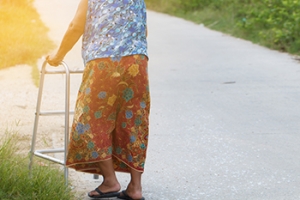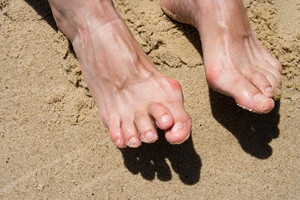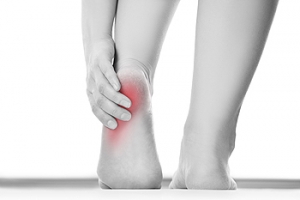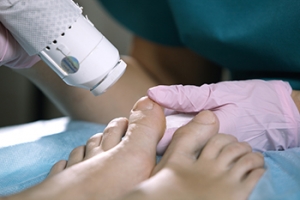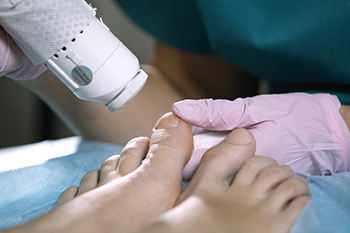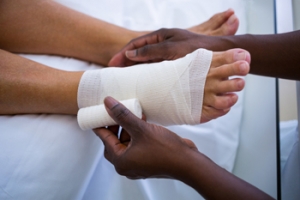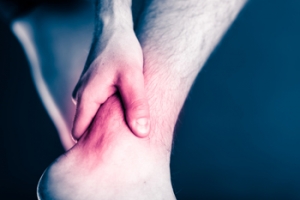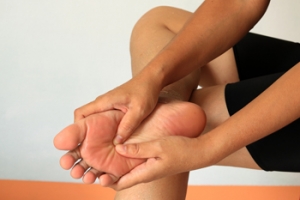Super User
Basic Foot Care Tips for Diabetics
Many people with diabetes also suffer from nerve damage, which, in turn, can lead to foot problems such as pain, numbness, muscle weakness, loss of balance, foot wounds/ulcers, and more. That is why it is important for people with diabetes to take care of their feet every day. Some very basic diabetic foot care tips include: making daily inspections for any breaks or redness in the skin, keeping the feet clean, dry, and moisturized, trimming the toenails straight across, wearing properly fitted shoes and moisture-wicking socks, never soaking the feet or walking barefoot, and going for regular checkups with your podiatrist. If you are diabetic and discover wounds on your feet, it is strongly suggested that you schedule an appointment with a podiatrist.
Diabetic foot care is important in preventing foot ailments such as ulcers. If you are suffering from diabetes or have any other concerns about your feet, contact one of our podiatrists from Piedmont Podiatry Associates. Our doctors can provide the care you need to keep you pain-free and on your feet.
Diabetic Foot Care
Diabetes affects millions of people every year. The condition can damage blood vessels in many parts of the body, especially the feet. Because of this, taking care of your feet is essential if you have diabetes, and having a podiatrist help monitor your foot health is highly recommended.
The Importance of Caring for Your Feet
- Routinely inspect your feet for bruises or sores.
- Wear socks that fit your feet comfortably.
- Wear comfortable shoes that provide adequate support.
Patients with diabetes should have their doctor monitor their blood levels, as blood sugar levels play such a huge role in diabetic care. Monitoring these levels on a regular basis is highly advised.
It is always best to inform your healthcare professional of any concerns you may have regarding your feet, especially for diabetic patients. Early treatment and routine foot examinations are keys to maintaining proper health, especially because severe complications can arise if proper treatment is not applied.
If you have any questions please feel free to contact one of our offices located in Greenville, and Easley, SC . We offer the newest diagnostic and treatment technologies for all your foot and ankle needs.
How to Care for Diabetic Foot
Millions of people are affected by diabetes each year. Diabetes damages blood vessels in all parts of the body, especially the feet. The legs and feet may develop slow blood flow, which causes neuropathy, or nerve damage. Once a diabetic patient develops neuropathy, it is important that the feet are well taken care of. Otherwise, the lower limbs may have to be amputated. This only happens in drastic cases, but it shows how seriously diabetic foot care should be taken.
It is very important to always wash and dry the feet thoroughly, especially in between the toes, if you’re a diabetic. Secondly, examining your feet and toes for redness or sores must be done, even if you do not feel pain. You may also want to examine your feet from the bottom. Try to avoid wearing colored socks to prevent infections that may occur from the dye. Well-fitting socks are also highly recommended.
A diabetic’s physician should always monitor their blood levels to test how well blood sugars are being maintained. In addition to giving advice about everyday eating habits and foot care, a physician may prescribe medicine to help with the diabetic patient’s neuropathy. It is also advised to see a podiatrist if experiencing any feet conditions. Toenails may also need to be taken care of by a podiatrist. This prevents patients from cutting too deeply around their cuticles, which can lead to infection.
A person can take care of their feet at home by following the instructions of their physician. Using creams on one’s feet is also an effective way to heal dryness. Proceed with caution when using tools to remove calluses, as severe diabetics may not be able to feel pain on their feet. If any complications arise do not hesitate to contact a podiatrist.
On a daily basis, diabetic feet must be checked. If you are ever concerned about something, contact your health care professional. You never want to wait until a wound becomes too severe to treat. If left untreated, gangrene may develop. Gangrene is a serious infection that can lead to sepsis or amputation. It is also important for diabetics to be on the lookout for ulcers. Ulcers are sores that develop from tissue loss on the skin. They can be quite painful and require intensive treatment. Early treatment and everyday inspection are imperative to staying healthy.
Strong Bones and Falling
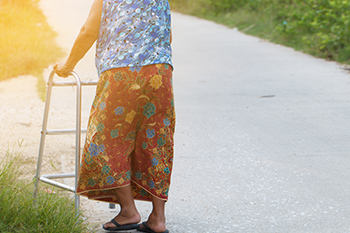 Falling is known to be a common cause of injury in elderly people. This may be a result of weakened bones as the aging process evolves and can cause discomfort and stress. Many patients have developed a habit of walking daily, and bones may be strengthened by performing leg exercises. Additionally, it can help to get regular physical and eye examinations, and this can aid in preventing falling. There are preventative methods that can be implemented in the household that can lessen the number of falls. These include removing worn rugs, improving lighting, and using a shower mat in the bathroom. It is suggested that shoes with non-slip soles are worn, in addition to using a cane or walker, if needed. The feet may be affected by falling, and a fractured foot is not uncommon. If you would like to learn about how to prevent falling, please speak with a podiatrist who can answer any questions you may have.
Falling is known to be a common cause of injury in elderly people. This may be a result of weakened bones as the aging process evolves and can cause discomfort and stress. Many patients have developed a habit of walking daily, and bones may be strengthened by performing leg exercises. Additionally, it can help to get regular physical and eye examinations, and this can aid in preventing falling. There are preventative methods that can be implemented in the household that can lessen the number of falls. These include removing worn rugs, improving lighting, and using a shower mat in the bathroom. It is suggested that shoes with non-slip soles are worn, in addition to using a cane or walker, if needed. The feet may be affected by falling, and a fractured foot is not uncommon. If you would like to learn about how to prevent falling, please speak with a podiatrist who can answer any questions you may have.
Preventing falls among the elderly is very important. If you are older and have fallen or fear that you are prone to falling, consult with one of our podiatrists from Piedmont Podiatry Associates. Our doctors will assess your condition and provide you with quality advice and care.
Every 11 seconds, an elderly American is being treated in an emergency room for a fall related injury. Falls are the leading cause of head and hip injuries for those 65 and older. Due to decreases in strength, balance, senses, and lack of awareness, elderly persons are very susceptible to falling. Thankfully, there are a number of things older persons can do to prevent falls.
How to Prevent Falls
Some effective methods that older persons can do to prevent falls include:
- Enrolling in strength and balance exercise program to increase balance and strength
- Periodically having your sight and hearing checked
- Discuss any medications you have with a doctor to see if it increases the risk of falling
- Clearing the house of falling hazards and installing devices like grab bars and railings
- Utilizing a walker or cane
- Wearing shoes that provide good support and cushioning
- Talking to family members about falling and increasing awareness
Falling can be a traumatic and embarrassing experience for elderly persons; this can make them less willing to leave the house, and less willing to talk to someone about their fears of falling. Doing such things, however, will increase the likelihood of tripping or losing one’s balance. Knowing the causes of falling and how to prevent them is the best way to mitigate the risk of serious injury.
If you have any questions, please feel free to contact one of our offices located in Greenville, and Easley, SC . We offer the newest diagnostic and treatment technologies for all your foot care needs.
Causes and Treatment for Hammertoe in Women
 After years of wearing high heels with pointy toe boxes, or other ill-fitting shoes, many women develop hammertoes in the second and third toe. A raised bump forms on the joint of the toe, which then rubs against the top of your shoe and can become painful. One of the first things you can do to alleviate some of the discomfort is to find shoes that do not aggravate the condition. Look for shoes with a lower heel, wider toe box and softer material on top. It is also a good idea to make an appointment with a podiatrist who can examine your foot and assess the need for orthotics to help align your foot as you walk. This can improve mobility and alleviate pressure around the toes. In some cases, surgery can help to correct the condition. Your podiatrist will be able to determine the best course of treatment for you.
After years of wearing high heels with pointy toe boxes, or other ill-fitting shoes, many women develop hammertoes in the second and third toe. A raised bump forms on the joint of the toe, which then rubs against the top of your shoe and can become painful. One of the first things you can do to alleviate some of the discomfort is to find shoes that do not aggravate the condition. Look for shoes with a lower heel, wider toe box and softer material on top. It is also a good idea to make an appointment with a podiatrist who can examine your foot and assess the need for orthotics to help align your foot as you walk. This can improve mobility and alleviate pressure around the toes. In some cases, surgery can help to correct the condition. Your podiatrist will be able to determine the best course of treatment for you.
Hammertoes can be a painful condition to live with. For more information, contact one of our podiatrists of Piedmont Podiatry Associates. Our doctors will answer any of your foot- and ankle-related questions.
Hammertoe
Hammertoe is a foot deformity that occurs due to an imbalance in the muscles, tendons, or ligaments that normally hold the toe straight. It can be caused by the type of shoes you wear, your foot structure, trauma, and certain disease processes.
Symptoms
- Painful and/or difficult toe movement
- Swelling
- Joint stiffness
- Calluses/Corns
- Physical deformity
Risk Factors
- Age – The risk of hammertoe increases with age
- Sex – Women are more likely to have hammertoe compared to men
- Toe Length – You are more likely to develop hammertoe if your second toe is longer than your big toe
- Certain Diseases – Arthritis and diabetes may make you more likely to develop hammertoe
Treatment
If you have hammertoe, you should change into a more comfortable shoe that provides enough room for your toes. Exercises such as picking up marbles may strengthen and stretch your toe muscles. Nevertheless, it is important to seek assistance from a podiatrist in order to determine the severity of your hammertoe and see which treatment option will work best for you.
If you have any questions, please feel free to contact one of our offices located in Greenville, and Easley, SC . We offer the newest diagnostic and treatment technologies for all your foot care needs.
The Basics of Plantar Fasciitis
Plantar fasciitis occurs when the plantar fascia—a long fibrous tissue spanning the sole of the foot—becomes damaged or torn due to overuse, obesity, or structural issues with the foot. Pain and stiffness from plantar fasciitis is typically worse in the morning upon waking, and gets better as the body warms up. You can help prevent plantar fasciitis from occurring by warming up before exercising, wearing shoes that fit well with structure in the heel and support in the arch, and gradually build up duration and intensity when modifying your workout routine. If you have pain in your heel, make an appointment with a podiatrist for an accurate diagnosis and treatment plan.
Plantar fasciitis can be very painful and inconvenient. If you are experiencing heel pain or symptoms of plantar fasciitis, contact one of our podiatrists from Piedmont Podiatry Associates. Our doctors can provide the care you need to keep you pain-free and on your feet.
What Is Plantar Fasciitis?
Plantar fasciitis is the inflammation of the thick band of tissue that runs along the bottom of your foot, known as the plantar fascia, and causes mild to severe heel pain.
What Causes Plantar Fasciitis?
- Excessive running
- Non-supportive shoes
- Overpronation
- Repeated stretching and tearing of the plantar fascia
How Can It Be Treated?
- Conservative measures – anti-inflammatories, ice packs, stretching exercises, physical therapy, orthotic devices
- Shockwave therapy – sound waves are sent to the affected area to facilitate healing and are usually used for chronic cases of plantar fasciitis
- Surgery – usually only used as a last resort when all else fails. The plantar fascia can be surgically detached from the heel
While very treatable, plantar fasciitis is definitely not something that should be ignored. Especially in severe cases, speaking to your doctor right away is highly recommended to avoid complications and severe heel pain. Your podiatrist can work with you to provide the appropriate treatment options tailored to your condition.
If you have any questions please feel free to contact one of our offices located in Greenville, and Easley, SC . We offer the newest diagnostic and treatment technologies for all your foot and ankle needs.
Exercises for Arthritis of the Big Toe
Arthritis, an inflammation of the joints, can cause pain and stiffness. One joint that frequently becomes affected is the big toe, which by throwing off your gait further affects other body parts. One way to help alleviate this syndrome is by doing simple exercises for the toe. Among them is the toe pull, which helps to increase mobility. Put your affected foot on a stool or chair. With one hand, hold the area where the toe meets the foot. With the other hand, gently pull the toe forward and flex it down for 10 to 20 seconds then let go. Repeat. Toe salutes are designed to stretch and build strength. Sit in a chair with your feet flat on the ground directly below the knees. Raise the big toe of one foot up, while the other toes remain flat. Hold for five seconds and relax. Then raise the four little toes up, while keeping the big toe flat. Repeat, and then change feet. If you plan to begin any exercise regime, it is best to schedule an appointment with a podiatrist who can monitor your activity and suggest other treatment options.
Arthritis can be a difficult condition to live with. If you are seeking treatment, contact one of our podiatrists from Piedmont Podiatry Associates. Our doctors can provide the care you need to keep you pain-free and on your feet.
Arthritic Foot Care
Arthritis is a term that is commonly used to describe joint pain. The condition itself can occur to anyone of any age, race, or gender, and there are over 100 types of it. Nevertheless, arthritis is more commonly found in women compared to men, and it is also more prevalent in those who are overweight. The causes of arthritis vary depending on which type of arthritis you have. Osteoarthritis for example, is often caused by injury, while rheumatoid arthritis is caused by a misdirected immune system.
Symptoms
- Swelling
- Pain
- Stiffness
- Decreased Range of Motion
Arthritic symptoms range in severity, and they may come and go. Some symptoms stay the same for several years but could potentially get worse with time. Severe cases of arthritis can prevent its sufferers from performing daily activities and make walking difficult.
Risk Factors
- Occupation – Occupations requiring repetitive knee movements have been linked to osteoarthritis
- Obesity – Excess weight can contribute to osteoarthritis development
- Infection – Microbial agents can infect the joints and trigger arthritis
- Joint Injuries – Damage to joints may lead to osteoarthritis
- Age – Risk increases with age
- Gender –Most types are more common in women
- Genetics – Arthritis can be hereditary
If you suspect your arthritis is affecting your feet, it is crucial that you see a podiatrist immediately. Your doctor will be able to address your specific case and help you decide which treatment method is best for you.
If you have any questions, please feel free to contact one of our offices located in Greenville, and Easley, SC . We offer the newest diagnostic and treatment technologies for all your foot care needs.
Read more about How to Care for Your Arthritic FootWhen the Wound on Your Foot Becomes an Ulcer
Wounds can occur on the feet from an injury, poor circulation, prolonged pressure from improperly fitted shoes, or complications from diseases like diabetes, neuropathy, and vascular disease. Over time, if these wounds do not close and the underlying tissue becomes affected, they are considered ulcers. These types of wounds are potentially dangerous – particularly in people with diabetes. Ulcers can lead to infections in the bone and skin. You can sometimes tell if the wound on your foot has become an ulcer if it is draining, emits a foul odor, or the tissue has become thickened, inflamed, or red. It is important to seek the professional wound care that a podiatrist can provide to help heal the wound and prevent more serious complications from developing. Podiatrists typically begin by cleaning the wound and removing any unhealthy tissue, termed debridement. Antibiotics may be prescribed if an infection is present. They may also suggest certain shoes and orthotics that will keep pressure off the wound and, in severe cases, perform surgery and other methods of wound care.
Wound care is an important part in dealing with diabetes. If you have diabetes and a foot wound or would like more information about wound care for diabetics, consult with one of our podiatrists from Piedmont Podiatry Associates. Our doctors will assess your condition and provide you with quality foot and ankle treatment.
What Is Wound Care?
Wound care is the practice of taking proper care of a wound. This can range from the smallest to the largest of wounds. While everyone can benefit from proper wound care, it is much more important for diabetics. Diabetics often suffer from poor blood circulation which causes wounds to heal much slower than they would in a non-diabetic.
What Is the Importance of Wound Care?
While it may not seem apparent with small ulcers on the foot, for diabetics, any size ulcer can become infected. Diabetics often also suffer from neuropathy, or nerve loss. This means they might not even feel when they have an ulcer on their foot. If the wound becomes severely infected, amputation may be necessary. Therefore, it is of the upmost importance to properly care for any and all foot wounds.
How to Care for Wounds
The best way to care for foot wounds is to prevent them. For diabetics, this means daily inspections of the feet for any signs of abnormalities or ulcers. It is also recommended to see a podiatrist several times a year for a foot inspection. If you do have an ulcer, run the wound under water to clear dirt from the wound; then apply antibiotic ointment to the wound and cover with a bandage. Bandages should be changed daily and keeping pressure off the wound is smart. It is advised to see a podiatrist, who can keep an eye on it.
If you have any questions, please feel free to contact one of our offices located in Greenville, and Easley, SC . We offer the newest diagnostic and treatment technologies for all your foot care needs.
The Many Possible Causes of Ankle Pain
 There are many types of injuries and conditions that can cause pain in your ankles, such as fractures or breaks in one or more of the ankle bones. The most common form of ankle pain is caused by lateral sprains, which occur when the ligaments that bind and support your ankle become overly stretched or torn. Pain with these types of sprains is typically felt on the outside of the ankle, at the site of the injury. Peripheral neuropathy, or nerve damage, can also cause ankle pain, as well as different types of arthritis, including gout and osteoarthritis. There are two types of Achilles tendon injuries that can create pain in the ankle: an Achilles rupture, which can also cause pain in the calf and heel, and Achilles tendinitis. The fluid-filled sac (bursa) at the back of the ankle and heel that protects the Achilles tendon can burst and cause pain in the ankle and heel, along with swelling and redness at the back of the heel. Since there are a variety of underlying causes that may be responsible for ankle pain, it is suggested that a podiatrist be consulted to diagnose and treat the condition properly.
There are many types of injuries and conditions that can cause pain in your ankles, such as fractures or breaks in one or more of the ankle bones. The most common form of ankle pain is caused by lateral sprains, which occur when the ligaments that bind and support your ankle become overly stretched or torn. Pain with these types of sprains is typically felt on the outside of the ankle, at the site of the injury. Peripheral neuropathy, or nerve damage, can also cause ankle pain, as well as different types of arthritis, including gout and osteoarthritis. There are two types of Achilles tendon injuries that can create pain in the ankle: an Achilles rupture, which can also cause pain in the calf and heel, and Achilles tendinitis. The fluid-filled sac (bursa) at the back of the ankle and heel that protects the Achilles tendon can burst and cause pain in the ankle and heel, along with swelling and redness at the back of the heel. Since there are a variety of underlying causes that may be responsible for ankle pain, it is suggested that a podiatrist be consulted to diagnose and treat the condition properly.
Ankle pain can be caused by a number of problems and may be potentially serious. If you have ankle pain, consult with one of our podiatrists from Piedmont Podiatry Associates. Our doctors will assess your condition and provide you with quality foot and ankle treatment.
Ankle pain is any condition that causes pain in the ankle. Due to the fact that the ankle consists of tendons, muscles, bones, and ligaments, ankle pain can come from a number of different conditions.
Causes
The most common causes of ankle pain include:
- Types of arthritis (rheumatoid, osteoarthritis, and gout)
- Ankle sprains
- Broken ankles
- Achilles tendinitis
- Achilles tendon rupture
- Stress fractures
- Bursitis
- Tarsal tunnel syndrome
- Plantar fasciitis
Symptoms
Symptoms of ankle injury vary based upon the condition. Pain may include general pain and discomfort, swelling, aching, redness, bruising, burning or stabbing sensations, and/or loss of sensation.
Diagnosis
Due to the wide variety of potential causes of ankle pain, podiatrists will utilize a number of different methods to properly diagnose ankle pain. This can include asking for personal and family medical histories and of any recent injuries. Further diagnosis may include sensation tests, a physical examination, and potentially x-rays or other imaging tests.
Treatment
Just as the range of causes varies widely, so do treatments. Some more common treatments are rest, ice packs, keeping pressure off the foot, orthotics and braces, medication for inflammation and pain, and surgery.
If you have any questions, please feel free to contact one of our offices located in Greenville, and Easley, SC . We offer the newest diagnostic and treatment technologies for all your foot care needs.
Ankle Pain
Pain experienced in the ankle can be caused by a multitude of conditions. While the most common cause is an ankle sprain, other possible problems can include arthritis, gout, ankle instability, an ankle fracture, nerve compression, or tendinitis. In more serious cases, ankle pain can be a sign of improper alignment of the foot or an infection.
Ankle pain can often be accompanied by symptoms such as redness, swelling, stiffness, and warmth in the affected area. Pain can be described differently depending on the condition: short, stabbing pain and a dull ache are some examples. If such symptoms are persistent and do not improve after time, be sure to schedule an appointment with your local podiatrist.
Depending on the condition causing your ankle pain, different treatments may be prescribed by your podiatrist. For ankle sprains, the first step in treatment involves rest, ice, elevation, and compression. Be sure to avoid placing pressure on the ankle, use an ice pack several times a day, and use a compression bandage and elevation to reduce swelling. Other, more serious conditions may require the assistance of certain drugs and medications such as nonsteroidal anti-inflammatory drugs (NSAIDs), physical therapy, or even cortisone injections.
Depending on the severity of your ankle pain and the condition behind it, recovery from ankle pain may take some time.
Consult with your foot and ankle doctor to best determine the cause of your ankle pain and the appropriate treatment.
Caring for Your Feet if You Have Peripheral Diabetic Neuropathy
If you are a diabetic, peripheral diabetic neuropathy makes any break in the skin of your feet potentially problematic. Peripheral diabetic neuropathy can cause nerve damage, which in turn, creates a lack of sensation. This disease is also responsible for circulation issues and other factors that contribute to a reduced capacity within your body to heal itself. Daily foot checks can help you detect and seek proper treatment for any developing wounds. Comfortable footwear and moisture wicking socks with no seams to rub against your foot may aide in wound prevention. It is also recommended to trim your nails regularly and keep your feet clean and dry. Regular check ups with a podiatrist should be an important component in your foot care and prevention plan.
Neuropathy
Neuropathy can be a potentially serious condition, especially if it is left undiagnosed. If you have any concerns that you may be experiencing nerve loss in your feet, consult with one of our podiatrists from Piedmont Podiatry Associates. Our doctors will assess your condition and provide you with quality foot and ankle treatment for neuropathy.
What Is Neuropathy?
Neuropathy is a condition that leads to damage to the nerves in the body. Peripheral neuropathy, or neuropathy that affects your peripheral nervous system, usually occurs in the feet. Neuropathy can be triggered by a number of different causes. Such causes include diabetes, infections, cancers, disorders, and toxic substances.
Symptoms of Neuropathy Include:
- Numbness
- Sensation loss
- Prickling and tingling sensations
- Throbbing, freezing, burning pains
- Muscle weakness
Those with diabetes are at serious risk due to being unable to feel an ulcer on their feet. Diabetics usually also suffer from poor blood circulation. This can lead to the wound not healing, infections occurring, and the limb may have to be amputated.
Treatment
To treat neuropathy in the foot, podiatrists will first diagnose the cause of the neuropathy. Figuring out the underlying cause of the neuropathy will allow the podiatrist to prescribe the best treatment, whether it be caused by diabetes, toxic substance exposure, infection, etc. If the nerve has not died, then it’s possible that sensation may be able to return to the foot.
Pain medication may be issued for pain. Electrical nerve stimulation can be used to stimulate nerves. If the neuropathy is caused from pressure on the nerves, then surgery may be necessary.
If you have any questions, please feel free to contact one of our offices located in Greenville, and Easley, SC . We offer the newest diagnostic and treatment technologies for all your foot care needs.







